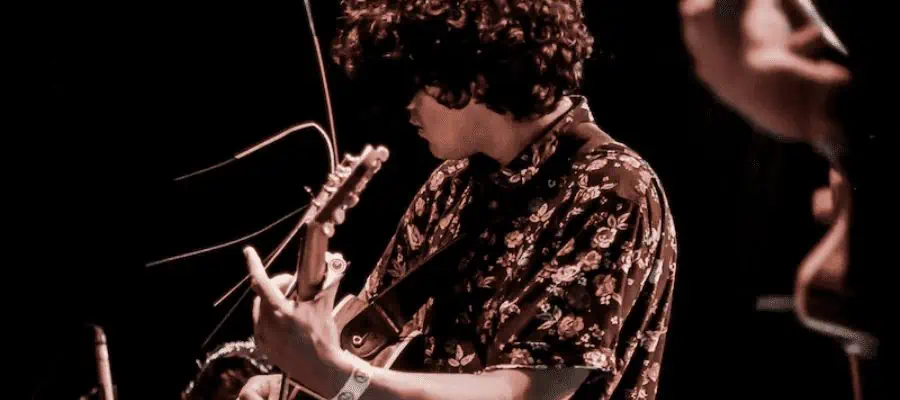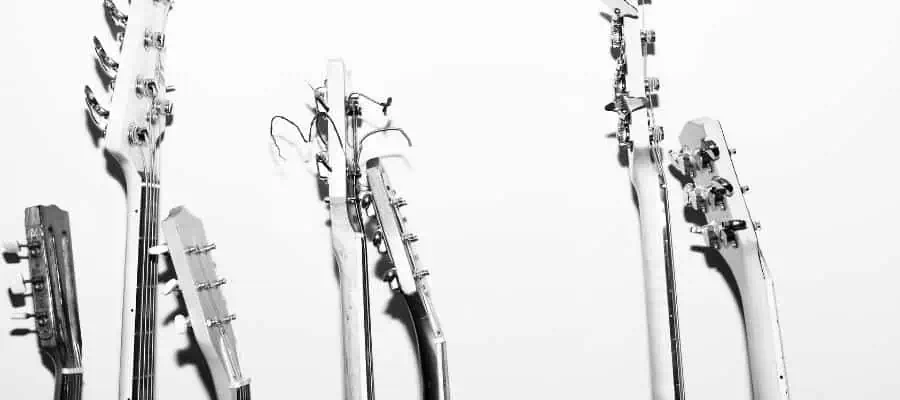When you glimpse a guitarist with uncut strings winding from their headstock, you might wonder if there’s a method to the madness. It’s more than just an aesthetic choice or a sign of laziness; leaving guitar strings uncut can hinge on various practical reasons.
Some guitarists believe that uncut strings can influence the instrument’s sustain and tone, though this is mainly subjective and debated within the music community. There is no proof or reason uncut strings can have any effect on the instrument’s sound or playability. The practice often comes down to personal preference or tradition.
Uncut strings are an aesthetical decision, giving guitarists a unique look. For instance, players like Tom Morello were advised early in their careers that uncut strings were a badge of honor, symbolizing one’s commitment to being in the “coolest band in town.” Others find it more convenient for quick restringing, especially in live performance situations where time is of the essence.
Ultimately, your decision to trim your guitar strings or let them dangle freely is yours, echoing your style and functional demands. Whether for convenience or pure rock ‘n’ roll flair, uncut strings are a detail that can say a lot about your playing philosophy.
Cultural and Aesthetic Reasons

When you see a guitarist on stage with a halo of untrimmed strings splayed out from the headstock, you’re witnessing a deliberate choice that often transcends functionality. This tradition, rooted in both cultural significance and a desire for visual distinction, serves as a nod to the past and a contemporary statement of individualism.
The aesthetic allure, deeply embedded in the rock and roll ethos, and the expression of personal style all contribute to why some guitarists leave their strings uncut.
Visual Appeal
Uncut strings can capture your attention, setting a guitar apart visually from the customary neatly trimmed look. The extra length of the strings can create a distinctive silhouette that is often considered:
- Cool-looking: The untrimmed strings can give a guitar a more rugged and raw appearance.
- Unique: It is a visual stamp of a guitarist’s individuality onstage.
Rock and Roll Tradition
The look of uncut strings has deep roots in rock and roll history. It’s a subtle homage to influential musicians who either couldn’t afford new strings or had to be ready for quick repairs during relentless gig schedules.
Uncut strings are a fashion that has come and gone through different eras. In the 60s, The Beatles was the first band to introduce it to the scenes, and, of course, everybody followed it. Later, it came back in the 80s for a while with metal bands, as they wanted to look scary and cool. In the 90s, of course, the grunge bands took uncut strings back to trend once again.
- Tribute: Retaining uncut strings is an homage to rock legends and the genre’s gritty beginnings.
- Heritage: It’s a nod when spare strings were a luxury for many touring musicians.
Personal Style
For you, as a guitarist, your instrument is an extension of your persona. Leaving strings uncut lets musicians articulate their personality.
- Signature mark: Just as fashion choices can reflect personal taste, so can the distinctive features of a musician’s instrument.
- Expression: Uncut strings can outward reflect an artist’s unique approach to life and music.
Functional and Practical Considerations

Those dangling ends serve a functional role beyond just making a fashion statement on stage. Their reasons are rooted in quick fixes, sound nuances, and the feel of the guitar. Let’s dive into the specifics.
Quick String Changes
When you’re performing live and break a string, time is of the essence. Uncut strings can be a lifesaver, allowing you to quickly tie the broken end back onto the tuning peg, effectively getting back to the music faster. Remember, this isn’t the norm for every guitarist, but those extra inches of string can make a significant difference if you’re in a pinch and need a fast solution.
Discussion on Tone and Playability
You might encounter some guitarists who say uncut strings affect tone and playability. However, there is no reason or proof that uncut strings can have any kind of effect on sustain, tone, or ease of play. This is just a personal choice of aesthetics and has no effect on the sound or playability of the guitar.
Conclusion
The reason behind the uncut strings is a blend of practicality and personal choice. You might see untrimmed strings on stage at a rock concert or in a friend’s garage, and it’s not always about aesthetics. Uncut strings can be a signature look or a nod to an influential musician who does the same. But they may also serve a function; longer strings allow for reshaping or reuse after boiling — an old-school trick to extend string life.
While there’s no definitive evidence that long strings aid in sustain or overall tone, it’s clear that this practice needs to be grounded in performance benefits. Guitarists like uncut strings for their reasons — they might like to feel the appearance or enjoy the convenience of quick string changes without worrying about the perfect length.
Remember, what works for one musician may not work for another. Guitar playing is as much about individual expression as it is about sound. So, if you’re deliberating whether to keep your strings long or cut them short, consider your preferences and the practicalities of your play style. As with most aspects of music, there’s room for your personal twist.

Recent Posts
Some guitarists insist on buying an expensive amplifier with their electric guitar. They assume that this is a must for every type of guitarist out there. However, in some situations, this isn’t...
Top 50 Free Realistic Guitar VST Plugins With Sound Examples
As technology has rapidly advanced in the recent decade, computers are stealing more and more roles from physical musical instruments and accessories. Nowadays, you do not need expensive amps,...

